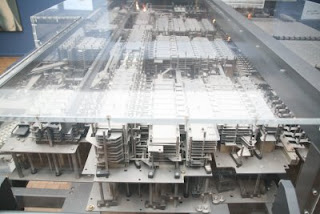
Germany is well known for its contributions to technology through out the ages. While I found the museum very interesting, I was disappointed with the audio guide (which is a separate charge) that guides you through the museum. Understandably most of the signs and descriptions are in German, and I was expecting, like some of the other audio guides in other museums (like the Pergamon Museum), there would be substantial detail on most of the exhibits. Instead, the audio guide only discussed the highlights, and some of the exhibits that I found really interesting were inaccessible :(
The museum of technology is in the grounds of one of Berlin's early central rail stations. Although it is no longer a train station, or a transport hub, it retains a strong connection with its past through its extensive collection of locomotives and railway history. As some one who loves trains and railways, this was definitely a highlight for me.

One of the entrances to the original train stations

There is a large outside, "garden" area of the museum. The railway yard heritage of the museum is retained in the garden.

The first electric train.

Internals of a steam engine

There is a large collection of models, and a model railway set up. This was not running when I visited unfortunately.

The Nazi government exploited railway technology, and in fact other emerging technologies such as radio and television like no other regime before it. The museum does not gloss over these facts.

Off course, what is most well known about the Nazi's usage of railways is the links to the concentration camps, where prisoners were carried off in carriages like this. Visitors are allowed to enter one such carriage.

Apparently, Berlin was built on barges, that carried goods through the rivers and canals of the city. This is the only remaining example of these old barges.

Germany is the birth place of modern typesetting, and there is an extensive display of early printing works. The printing presses for graphical works is especially impressive.


Konrad Zuse is credited with creating the earliest working computers, and the museum has a recreation (by Zuse himself) of the first computer. We have come a long way since!

A later Zuse computer, using vacuum tubes instead.

The Graphomat Z64 (1961), a printer that could print large maps and plans.
No comments:
Post a Comment